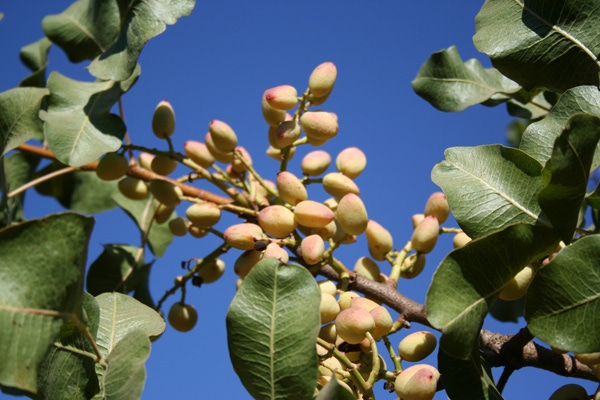June 1, 2016

The 2016 pistachio season began early for Arizona grower Steve Seplak when his 20-acre SAS-Z Nuts pistachio orchard near Willcox, Ariz. began blooming in the first few days of March - three weeks earlier than usual.
Aided by warm days with temperatures typically reaching into the mid-to-high 60s, most of the shells formed by the end of May.
His trees planted 23-24 years ago produce an average of about 2,500 pounds of in-shell nuts annually. However, by mid-May, the nut numbers on Seplak’s trees suggested this on-year crop could surpass that figure.
“We’re probably looking at potential yields of 2,800-3,000 pounds per acre this season,” the Cochise County grower says.
This would be much higher than Seplak harvested last year when a hard pre-bloom freeze in late March and early April knocked tree growth back significantly.
“We shook the trees twice at harvest but only about 14,000 pounds of nuts on the entire 20-acre orchard dropped. The rest remained on the trees,” he said.
“Production just barely covered the bills. It was like that in pistachio orchards throughout the valley.”
However, the smaller yields had a bright spot. The nuts Seplak gleaned last year fetched a record high $4 per pound in-shell – or 50 cents more than for his 2014 pistachio crop.
Seplak is a member of the American Pistachio Growers’ board of directors, and the former president of the Arizona Pistachio Association.
As of mid-May, his tress had received less than an inch of rain since the first of the year. Typically, rainfall during this period totals around 3½ inches.
Seplak pumps groundwater for his micro-sprinkler irrigation system from a depth of 483 feet at the rate of 135 gallons per minute.
“Our water table has stayed pretty stable over the past 14 or so years that I’ve been farming here, but it hasn’t risen any,” he says.
To compensate for low soil levels of boron, copper, and zinc, Seplak fertilizes the trees with these nutrients several times a year in the irrigation water. Rates are based on results of an early spring leaf analysis.
His first application this year was in early May. He typically applies the materials three times during the season.
Dry weather this spring may have contributed to an earlier-than-usual appearance of aphids in his orchard in early May, Seplak noted. He treated the trees with an insecticide to control the aphids. Depending on the pest numbers, he may spray again in late June.
He hasn’t seen any stink bugs yet which usually appear in early May.
While these are Seplak’s two main insect concerns, he also encounters four-legged threats to his trees.
“All year long, deer and javelinas chew on the foliage and strip branches off the trees,” he says. “The orchard can’t be fenced. I’ve tried the noise of cannons to keep them out. The deer just come back and sleep under the shade of the trees.”
If his pistachio crop continues normal development, Seplak expects to harvest the nuts in late August. He hopes the monsoon rain storms hold off until he’s finished.
“Over the last two years, we’ve been hit with rain at the tail end of harvest which really slowed us down,” Seplak says. “Harvest equipment doesn’t go through mud very well.”
You May Also Like




